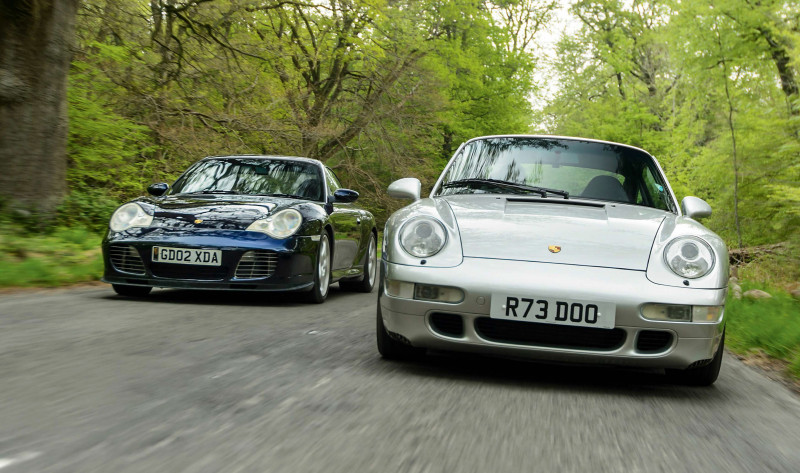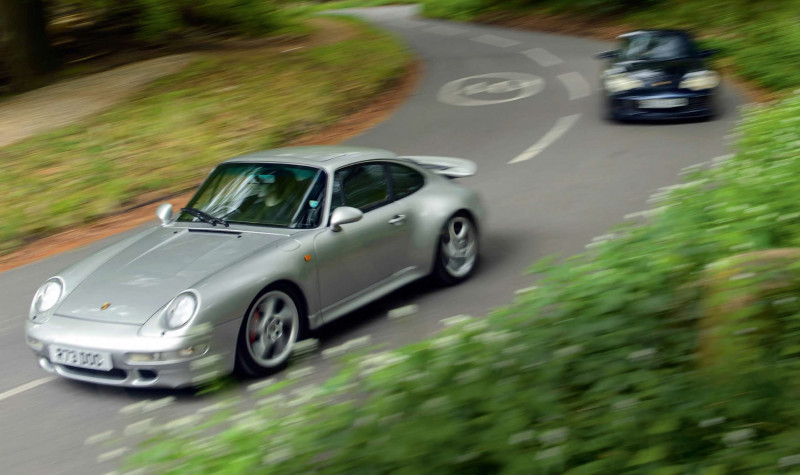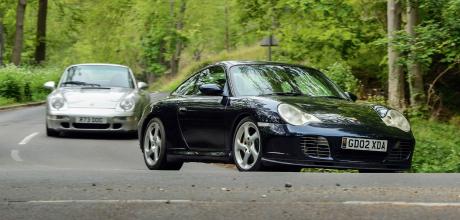1996 Porsche 911 Carrera 4S 993 vs 2001 911 Carrera 4S 996.2
These two wide-bodied modern classics are keenly sought after by enthusiasts, but which model offers the better drive?
Written and photographed by Steve Hall
C4SLast air-cooled v first water-cooled 4S: which is the best widebodied Carrera
993 v 996 C4S
The last air-cooled, wide-bodied Carrera takes on the first water-cooled model. Which is the better drive?
A wide-bodied Porsche isn’t anything new. All 992-generation 911s are ‘wide-bodied’ these days, and you can go right back to the 1980s to discover the first use of Zuffenhausen’s M491 option code, which back then meant ‘Turbo look’.

“The 996 is straight out of the sports car playbook, with its brawnier mid-range transforming into a proper rush for the redline”
This option code for the 3.2 Carrera gave you a 911 Turbo appearance, though not the turbocharger. A wide-bodied 964 followed, albeit as standard spec rather than being an option with the 964 Anniversary and Works Turbo-look Cabriolet. By the turn of the 993 a Turbo-spec wide body was assigned to the special 992 Carrera S and 4S models. A wide-bodied 911 Carrera had arrived, starting a trend that remained for the 996 (in 4S form only), as well as the 997, 991 and 992 generations that followed. We’ve gathered the first two generations of Carrera 4S today, and we can’t wait to climb behind the wheel of them both.

At first glance the 996 C4S, just like the 993 predecessor which debuted that C4S moniker, is ‘simply’ a Turbo-bodied, normally aspirated model devoid of the side intakes. But then you stroll round the 996 and view it from the rear three-quarter, where the detail that makes the 996 C4S so desirable reveals itself. If the idea behind that lovely strip of red between the rear lights was to hark back to the similarly styled 993, then it’s a stroke of genius. The 993, of course, has no issue in this respect. Every 993 that rolled out of Weissach subscribed to the ‘small but perfectly formed’ mantra. Everyone will have their personal favourite, from the lean and lithe Carrera to the aggressive arse of the, er, RS. But there’s no denying the innate rightness of the 993 shape was divisive to absolutely nobody at its 1994 debut, and it remains something of an icon today. Under Harm Lagaay’s direction, Tony Hatter did a sensational job of bringing the Gen4 911 up to date, usurping the unloved (can you believe that now?) 964 just five years after it was launched.
It helped that a certain Ulrich Bez joined Weissach in 1989 – bringing Harm with him – and the pair were empowered by management to make more fundamental changes to the 911 than had been allowed for the 964. Previously, stylists had been told not to alter anything above the waistline, instead continuing the G-series silhouette that, while iconic, was by then 15 years old. And while Ulrich and Harm didn’t win every budgetary argument during the 993’s inception, they did come top in a few crucial ones. So while the 993 has the more upright screen, unrecessed wipers and roof rails that the designers would rather have altered for a sleeker, more modern shape (does that sound like a 996 – anyone?), they did have free rein to add curves and style to the mix. This meant we got that beautifully wrought hip-line at the rear and headlamps canted back for the first time in a 911. But perhaps most crucial of all were engineering wins, which saw the 964’s torsion beam axle consigned to history in favour of a multi-link setup, while the adoption of a torsion coupling for four-wheel-drive models banished the 964’s expensive and heavy transfer box with its permanent 1:2 power split that made the 964 C4 somewhat leaden and unresponsive. These things, and many more, combined to create a driving experience more engaging than the 964, despite the 993 essentially being a heavily updated version of the Gen3 911. Yet as much as Porsche pushed the boat out with the 993, we all know that the biggest, most divisive change came with the arrival of a clean sheet ‘996’. This cast aside some of the elements that the purist would tell you were fundamental to a 911. I mean, you’re going to cool the engine with… water? Despite being the de facto method of cooling just about every car in existence, air-cooled zealots saw the 996 as being designed by heretics. And then there are the headlamps. These look fantastic nowadays (we’re big 996 fans here at DrivesToday), but they certainly didn’t receive critical acclaim at launch. Harm did get his sleeker roofline and recessed wipers, though…
Both 993 and 996 made something unique of the C4S moniker. With generations that followed, C4S became a spec level denoting the more powerful ‘S’ engine option married to a four-wheel-drive powertrain and wider body. Although this mirrors the uplift received by the 993 and 996, those models were standalone within their respective ranges and brought mechanical specification and styling unique to each. And if all this sounds like a melange of words to justify bringing these two together, then we can live with that because it should prove a fascinating encounter. The 996, the long-underrated 911 finally being recognised as a bona fide modern classic, conveying analogue thrills with modern performance and usability; versus the 993, a doyen of the 911 family, a classically involving car wrapped up in one of the loveliest shapes to come out of Weissach – and the air-cooled finale, as if it needed any more cachet.
Cachet is heavily reflected in the respective values of this pair, for while a good 996 C4S (manual coupes for comparison) showing similar miles may command a price in the mid- to high £20k price range, the 993 C4S has punched through the £100k barrier for admittedly immaculate examples. That was Turbo money pre-pandemic. Basic market forces play a huge part in this. Fewer than 7,000 993 C4S were produced compared to 18,500 996 models (including 1,200 Cabriolets). Factor in general market desirability of each and it’s easy to see why the older model commands a hefty premium.
But does a price disparity that’s 400 per cent in favour of the classic stand up to scrutiny when viewed the way Porsche would have when conceiving each model – namely, as a sports car designed to deliver driving and ownership pleasure? It’ll be interesting finding out.
Our good friends at RPM Technik have been kind enough to accommodate our desire to bring this pair together, providing the gorgeous 993 C4S they currently have available for £108,995. The 996’s presence necessitates full disclosure because it’s my own car. It’s not for sale (yet), but if someone offered me £100k I could be persuaded to part with it. In reality, my 117k 996 is at the lower end of the C4S market because of the mileage, but it’s been well maintained and will make a worthy foil for the 993.
It does somewhat disappear in the presence of the 993 though. While the 996 exhibits some signs of a car well enjoyed, the 993 could be showroom fresh; its condition completely at odds with its 73,000 miles. And if the 996 has aged rather nicely in the eyes of DrivesToday, the 993 has always been stunning to look at, overshadowing the 996 with its blend of delicate proportions, delicious curves and timelessly elegant glasshouse. This car sports the popular optional Turbo rear spoiler, adding some muscularity to this 993’s aesthetic that suggests it’s got enough brawn to trade punches with its younger sibling.
There may be only four years separating these cars, but as I climb into the 993 it feels more like 24 years. Which, with much of the architecture traceable to the G-model, is understandable. The glasshouse feels airy, its spindly pillars and upright windscreen delivering an unencumbered forward view. Pedals are offset slightly to the left, and being floor mounted their action feels slightly odd to begin with, but you quickly become accustomed to this. Initially it feels like the brake pedal is too high for smooth manipulation of the throttle, but once up and running everything clicks. The clutch is the only fly in the ointment with its long travel and light action that lacks feedback, so you engage drive more from engine note than feeling a bite point.
Other signs of the times: it’s easy to reach over and touch the passenger door, such is the compact nature of this interior, but the biggest giveaway is the haphazard approach to ergonomics. If anything dates the 993 from the driver’s seat it’s the scattergun placement of much of the switchgear, which makes the 996 seem a paragon of ergonomic excellence. It usurps the 996 for quality, though: every switch, button and slider feels solid and long-lasting. Much has been said of the 996’s interior: a lot of it negative, some of it fair. It was clearly conceived with cost of production in the equation, a fact belied by some scratchy plastics, flimsy switchgear and a creaky centre console. It is, however, streets ahead of the 993 for sheer usability with an exemplary driving position and everything you want laid out in a clear and logical fashion. The steering wheel feels lovely. It’s perfectly sized in diameter and rim thickness, with two-way adjustment that the 993 lacks. Given you spend most of your time looking out, how much touchy-feely plastics matters is subjective.
What is never subjective when discussing the merits of a Porsche 911 is how they drive. It’s time to find out. The 993 chunters into life and settles to a throaty, bassy idle. The 964-derived M64 motor was re-engineered not just for extra power (272bhp, 285bhp from 1996 with the advent of VarioRam) but for refinement; the lighter, stiffer motor negating the need for the 964’s vibration damper. It’s apparent as soon as you start driving. The M64 whips round the rev counter between gears, making smooth downchanges challenging – especially third to second because there’s a much bigger gap between ratios here than in the upper gears, which feel like sprint gearing with minimal rev drops.
Acceleration is butter smooth. Once beyond 3,000rpm the motor just builds momentum in an incredibly silky, linear fashion as you home in on the 7,000rpm redline. Aided by a 6-speed gearchange that’s light, accurate and will snick through as fast as you like, the 993 is one of those cars that’s deceptively quick. It doesn’t kick you in the back with mid-range grunt – it just relentlessly builds speed.
The 996 bosses it, though. It’s 50kg lighter, 35bhp more powerful and slippier of shape, and it asserts its performance authority any time you want. And if the 993 comes across somewhat GT, the 996 is straight out the sports car playbook, with its brawnier midrange transforming into a proper rush for the redline accompanied by a gritty, immersive flat six howl.
Push the 996 through a series of bends and you’ll find a chassis perfectly attuned to the tone set by the M96 engine, because for all the critique the 996 may have received over the years this is why they’re making a comeback. The steering is beautifully judged with gearing perfectly in tune to the rate of response the front end delivers, the level of feedback convincing you there’s no way a pair of driveshafts are part of the picture. It’s the kind of car you roll into a corner from the shoulders, a quarter-turn enough for all but the tightest hairpins.
On faster roads it displays rock-solid body control. Feedback through the seat of your pants gives you faith to push on and enjoy its abilities, safe in the knowledge the rear will go exactly where you want it. In slower corners the 996 is happy to indulge the more extrovert driver. Braking into an apex elicits a delicious rotation from the rear axle with options to then lean on the four-wheel-drive traction or allow the slide to build, before exiting with some opposite lock. It feels natural and intuitive to drive this way, with the 996’s lightness of touch and benign demeanour inviting you into its way of doing things. The 993 has its own way of doing things. Of course, there are shared 911 traits: the steering still writhes in your hands; the nose bobbles away; the familiar flat six timbre. But it feels weightier than the 996, with more heft to the steering and less vibrant feedback through the rim. It has a more deliberate way of addressing the road, and wants firmer inputs from the driver to command its attention. The powertrain carries a slightly more GT vibe, capable of covering ground at great pace with little fuss from the chassis. You can maintain impressive speed into a corner – the nose wants you to pour it in with more lock than the 996, but it rewards with a steadfastly stable passage. Both cars possess excellent brakes with an abundance of stopping power.
I approached this encounter expecting to find a pair similar of character with the need to pick a winner, but it doesn’t play out like that. The 996 is the more expressive of the two. It wants to get down and dirty – it’s the sports car. The 993 is less effusive and requires more effort from the driver to reveal its qualities. It’s the kind of car that would be a slow burner, only revealing more and more layers of ability with time. From the super-smooth motor to the measured way it covers ground, infused with an indomitable feeling of heft and quality the 996 lacks, it’s the GT of this pair. Perhaps predictably, you could easily justify having both in your garage.
MIDDLE Inside the cabin of the 996, and the build quality of some of the plastics and switchgear is lacking on occasion.
OPPOSITE The 996 C4S used the same watercooled M96 engine as found in the 996.2 C2 and C4 with 320bhp.
OPPOSITE All three of the 993’s pedals are mounted to the floor.
MIDDLE Thin pillars afford the driver a great deal of visibility in the 993.
LEFT The 993’s 964-derived M64 engine features a lighter, stiffer motor that removes the need for any vibration dampening measures


